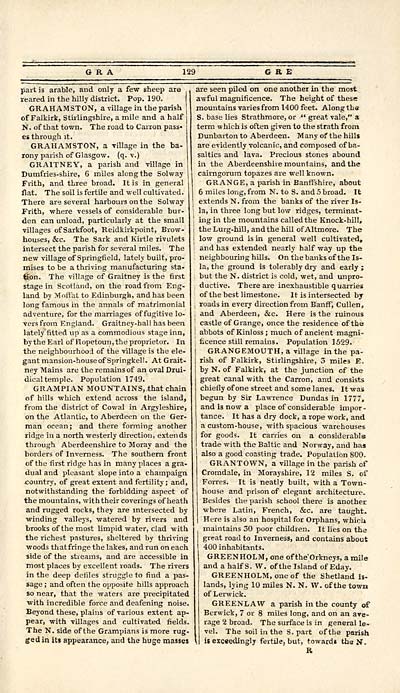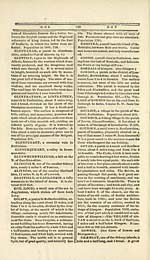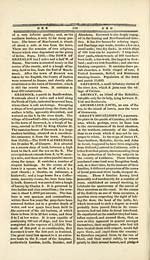Gazetteer of Scotland
(131) Page 129
Download files
Complete book:
Individual page:
Thumbnail gallery: Grid view | List view

SEA 3
part is arable, and only a few sheep are
reared in the hilly district. Pop. 190.
GRAHAM STON, a village in the parish
of Falkirk, Stirlingshire, a mile and a half
N. of that town. The road to Carron pass*
es through it.
GRAHAMSTON, a village in the ba-
rony parish of Glasgow, (q. v.)
GRA1TNEY, a parish and village in
Dumfries-shire, 6 miles along the Solway
Frith, and three broad. It is in general
fiat. The soil is fertile and well cultivated.
There are several harbours on the Solway
Frith, where vessels of considerable bur-
den can unload, particularly at the small
villages of Sarkfoot, Reidkirkpoint, Brow-
houses, &c. The Sark and Kirtle rivulets
intersect the parish for several miles. The
new village of Springfield, lately built, pro-
mises to be a thriving manufacturing sta-
tion. The village of Graitney is the first
stage in Scotland, on the road from Eng-
land by Moffat to Edinburgh, and has been
long famous in the annals of matrimonial
adventure, for the marriages of fugitive lo-
vers from England. Graitney-hall has been
lately 'fitted up as a commodious stage inn,
bytheEarl of Hopetoun, the proprietor. In
the neighbourhood of the village is the ele-
gant mansion-house of Springkell. At Grait-
ney Mains are the remains of an oval Drui-
dical temple. Population 1749.
GRAMPIAN MOUNTAINS, that chain
of hills which extend across the island,
from the district of Cowal in Argyleshire,
on the Atlantic, to Aberdeen on the Ger-
man ocean; and there forming another
ridge in a north westerly direction, extends
through Aberdeenshire to Moray and the
borders of Inverness. The southern front
of the first ridge has in many places a gra-
dual and pleasant slope into a champaign
country, of great extent and fertility ; and,
notwithstanding the forbidding aspect of
the mountains, withtheir coverings of heath
and rugged rocks, they are intersected by
winding valleys, watered by rivers and
brooks of the most limpid water, clad with
the richest pastures, sheltered by thriving
woods thatfringe the lakes, and run on each
side of the streams, and are accessible in
most places by excellent roads. The rivers
in the deep defiles struggle to find a pas-
sage ; and often the opposite hills approach
so near, that the waters are precipitated
with incredible force and deafening noise.
Beyond these, plains of various extent ap-
pear, with villages and cultivated fields.
The N. side of the Grampians is more rug-
ged in its appearance, and the huge masses
are seen piled on one another in the most
awful magnificence. The height of these
mountains varies from 1400 feet. Along the
S. base lies Strathmore, or " great vale," a
term which is often given to the strath from
Dunbarton to Aberdeen. Many of the hills
are evidently volcanic, and composed of ba-
saltics and lava. Precious stones abound
in the Aberdeenshire mountains, and the
cairngorum topazes are well known.
GRANGE, a parish in Banffshire, about
6 miles long, from N. to S. and 5 broad. It
extends N. from the banks of the river Is-
la, in three long but low ridges, terminat-
ing in the mountains called the Knock-hill,
the Lurg-hill, and the hill of Altmore. The
low ground is in general well cultivated,
and has extended nearly half way up the
neighbouring hills. On the banks of the Is-
la, the ground is tolerably dry and early ;
but the N. district is cold, wet, and unpro-
ductive. There are inexhaustible q uarries
of the best limestone. It is intersected by
j roads in every direction from Banff, Cullen,
and Aberdeen, &c. Here is the ruinous
castle of Grange, once the residence of the
! abbots of Kinloss; much of ancient magni-
. ficence still remains. Population 1529.
| GRANGEMOUTH, a village in the pa-
rish of Falkirk, Stirlingshire, 5 miles E.
by N. of Falkirk, at the junction of the
great canal with the Carron, and consists
chiefly of one street and some lanes. It was
begun by Sir Lawrence Dundas in 1777,
and is now a place of considerable impor -
tance. It has a dry dock, a rope work, and
a custom-house, with spacious warehouses
for goods. It carries on a considerable
trade with the Baltic and Norway, and has
also a good coasting trade. Population 800.
GRANTOWN, a village in "the parish of
Cromdale, in Morayshire, 12 miles S. of
Forres. It is neatly built, with a Town-
house and prison of elegant architecture.
Besides the parish school there is another
where Latin, French, &c. are taught.
Here is also an hospital for Orphans, which
maintains 30 poor children. It lies on the
great road to Inverness, and contains about
400 inhabitants.
GREENHOLM, one of the'Orkneys, a mile
and a half S. W. of the Island of Eday.
GREENHOLM, one of the Shetland is-
lands, lying 10 miles N. N. W. of the town
of Lerwick.
GREENLAW a parish in the county of
Berwick, 7 or 8 miles long, and on an ave-
rage 2 broad. The surface is in general le-
vel. The soil in the S. part of the parish
\ it exceedingly fertile, but, towards the N,
part is arable, and only a few sheep are
reared in the hilly district. Pop. 190.
GRAHAM STON, a village in the parish
of Falkirk, Stirlingshire, a mile and a half
N. of that town. The road to Carron pass*
es through it.
GRAHAMSTON, a village in the ba-
rony parish of Glasgow, (q. v.)
GRA1TNEY, a parish and village in
Dumfries-shire, 6 miles along the Solway
Frith, and three broad. It is in general
fiat. The soil is fertile and well cultivated.
There are several harbours on the Solway
Frith, where vessels of considerable bur-
den can unload, particularly at the small
villages of Sarkfoot, Reidkirkpoint, Brow-
houses, &c. The Sark and Kirtle rivulets
intersect the parish for several miles. The
new village of Springfield, lately built, pro-
mises to be a thriving manufacturing sta-
tion. The village of Graitney is the first
stage in Scotland, on the road from Eng-
land by Moffat to Edinburgh, and has been
long famous in the annals of matrimonial
adventure, for the marriages of fugitive lo-
vers from England. Graitney-hall has been
lately 'fitted up as a commodious stage inn,
bytheEarl of Hopetoun, the proprietor. In
the neighbourhood of the village is the ele-
gant mansion-house of Springkell. At Grait-
ney Mains are the remains of an oval Drui-
dical temple. Population 1749.
GRAMPIAN MOUNTAINS, that chain
of hills which extend across the island,
from the district of Cowal in Argyleshire,
on the Atlantic, to Aberdeen on the Ger-
man ocean; and there forming another
ridge in a north westerly direction, extends
through Aberdeenshire to Moray and the
borders of Inverness. The southern front
of the first ridge has in many places a gra-
dual and pleasant slope into a champaign
country, of great extent and fertility ; and,
notwithstanding the forbidding aspect of
the mountains, withtheir coverings of heath
and rugged rocks, they are intersected by
winding valleys, watered by rivers and
brooks of the most limpid water, clad with
the richest pastures, sheltered by thriving
woods thatfringe the lakes, and run on each
side of the streams, and are accessible in
most places by excellent roads. The rivers
in the deep defiles struggle to find a pas-
sage ; and often the opposite hills approach
so near, that the waters are precipitated
with incredible force and deafening noise.
Beyond these, plains of various extent ap-
pear, with villages and cultivated fields.
The N. side of the Grampians is more rug-
ged in its appearance, and the huge masses
are seen piled on one another in the most
awful magnificence. The height of these
mountains varies from 1400 feet. Along the
S. base lies Strathmore, or " great vale," a
term which is often given to the strath from
Dunbarton to Aberdeen. Many of the hills
are evidently volcanic, and composed of ba-
saltics and lava. Precious stones abound
in the Aberdeenshire mountains, and the
cairngorum topazes are well known.
GRANGE, a parish in Banffshire, about
6 miles long, from N. to S. and 5 broad. It
extends N. from the banks of the river Is-
la, in three long but low ridges, terminat-
ing in the mountains called the Knock-hill,
the Lurg-hill, and the hill of Altmore. The
low ground is in general well cultivated,
and has extended nearly half way up the
neighbouring hills. On the banks of the Is-
la, the ground is tolerably dry and early ;
but the N. district is cold, wet, and unpro-
ductive. There are inexhaustible q uarries
of the best limestone. It is intersected by
j roads in every direction from Banff, Cullen,
and Aberdeen, &c. Here is the ruinous
castle of Grange, once the residence of the
! abbots of Kinloss; much of ancient magni-
. ficence still remains. Population 1529.
| GRANGEMOUTH, a village in the pa-
rish of Falkirk, Stirlingshire, 5 miles E.
by N. of Falkirk, at the junction of the
great canal with the Carron, and consists
chiefly of one street and some lanes. It was
begun by Sir Lawrence Dundas in 1777,
and is now a place of considerable impor -
tance. It has a dry dock, a rope work, and
a custom-house, with spacious warehouses
for goods. It carries on a considerable
trade with the Baltic and Norway, and has
also a good coasting trade. Population 800.
GRANTOWN, a village in "the parish of
Cromdale, in Morayshire, 12 miles S. of
Forres. It is neatly built, with a Town-
house and prison of elegant architecture.
Besides the parish school there is another
where Latin, French, &c. are taught.
Here is also an hospital for Orphans, which
maintains 30 poor children. It lies on the
great road to Inverness, and contains about
400 inhabitants.
GREENHOLM, one of the'Orkneys, a mile
and a half S. W. of the Island of Eday.
GREENHOLM, one of the Shetland is-
lands, lying 10 miles N. N. W. of the town
of Lerwick.
GREENLAW a parish in the county of
Berwick, 7 or 8 miles long, and on an ave-
rage 2 broad. The surface is in general le-
vel. The soil in the S. part of the parish
\ it exceedingly fertile, but, towards the N,
Set display mode to: Large image | Transcription
Images and transcriptions on this page, including medium image downloads, may be used under the Creative Commons Attribution 4.0 International Licence unless otherwise stated. ![]()
| Gazetteers of Scotland, 1803-1901 > Gazetteer of Scotland > (131) Page 129 |
|---|
| Permanent URL | https://digital.nls.uk/97423266 |
|---|

